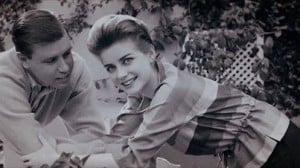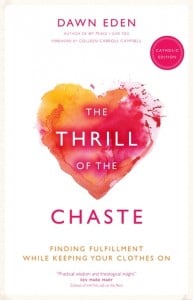In Part I of my interview with Mother Dolores Hart, she shared an insight that struck me as being profoundly important to our understanding of the vagaries of love: “all love relationships don’t end at the altar”.
What is love but a means to an end, the end being to become for each other a model of God? Not an idol, nor an icon/image but a model that helps us to know more fully the depths the Creator’s love for each of us. 
Ponder it: here were Dolores Hart, beautiful young actress and Don Robinson, handsome young man; in love and engaged to be married, because that is what love — in its romance, its spiritual and corporeal excitements — is supposed to lead to, right? Our whole society is formed on this assumption, and is currently watching the definition of marriage be stretched in a way that — approve or disapprove — contradicts what has been the fundamental understanding of the word for millennia.
This young couple ended up not marrying (and living a continent apart) and yet continued to love each other with such an enduring faithfulness and depth that they are for us perhaps God’s purposeful (and timely) exhibit of what the church means when it uses the word agape. Their story makes the argument — the disdained and unpopular argument — that love can be deeply felt and fully expressed even as it remains chaste or celibate; that the sacrificial element of chastity may well be the catalyst for the plumbing of depths that might not otherwise be reached in living within the “ordinary” experience of marriage.
I say “ordinary” only because while our society has its entrenched arguments about what marriage is or is not, our high divorce rates are evidence that marriages depths — which are sounded through acts of personal sacrifice — are largely going unreached, perhaps because the office of marriage has been, for so long, taken for granted. And too, perhaps because no matter how often we see a crucifix we simply do not understand the concept of sacrifice, beyond our Memorial Day speeches, anymore.
Agape and marriage; neither of them are actual “rights”, but are they Offices? That question gives us a great deal to think about — and to talk about, if our conversations were not so frequently held hostage to a tyranny of sentimentalism and emotionalism that precludes a genuine exchange of thought, and of actual hearing.
It is a conversation that should be held — and a point that should be made — even after gay marriage becomes a common thing, because in the inevitable divisions that are coming our way the concept of agape may become lost when it is most needed.
 In this second part of our chat, which came about thanks to a long promotional tour for Ignatius Press’ The Ear of the Heart, Mother Dolores talks about obedience, monastic chant, and illness, and to the surprises in store for her when she allowed herself to be led by love — again, the power of agape; the deep love of friendship — into becoming the coffin-maker for her monastic community. And we finally find out why she sometimes wears that jazzy beret!
In this second part of our chat, which came about thanks to a long promotional tour for Ignatius Press’ The Ear of the Heart, Mother Dolores talks about obedience, monastic chant, and illness, and to the surprises in store for her when she allowed herself to be led by love — again, the power of agape; the deep love of friendship — into becoming the coffin-maker for her monastic community. And we finally find out why she sometimes wears that jazzy beret!
You must be feeling like you’re ready to go home get ready to go back; are you feeling a little overwhelmed by all of this?
It’s not so much being overwhelmed. I felt like I wanted to go back about twenty minutes after I left! (Laughter) Yes, because I just that’s where my heart is –- although I have a wonderful assistant, Judith, who has come with me and helps me maintain my sanity and gives me my medication at the right time and takes care of all those little things to keep this ship on deck and working. And Mother Abbess David Serna — she is the second Abbess — when I asked her “Do I really have to do this?” she said “Of course, you dumb thing. Of course! It’s your mission. Just do it. Be quiet, do it and come home.” (Laughter)
You mention your medication, can you talk a little bit about what sounds like the harrowing experience of trying to get a diagnosis and treatment for your peripheral neuropathy? I’m wondering if you can share a little bit about what your illness has taught you about the love of God?
Well, I’ll tell you, the struggle the struggle, as you just mentioned, was something I never anticipated in my life, and when I saw myself weighing 92 pounds, in a wheelchair and looking like a scarecrow, I thought, “What has happened to my life?” And it was finding the right doctor who could give me back a capacity to be myself, first of all, and then to get my body back.
It’s the realization that your own body is such a treasured gift and when you’re ill you go through something of an inhabitation by [a kind of evil] that wants to take that body from you. And I’m so aware of the fact that illness is not god’s will for us; illness is the effect of a sinful burden that we, as humans, must bear and we have many ways of talking about it. We can speak about it from the bible, or from any tradition — Jewish, Muslim — everyone has a way of talking about the spirit of evil that takes away the great gift of life. And that gift is centered in our body. That’s the thing that Jesus Christ said in the New Testament; in the New Kingdom — in the life after, you will be given [a fullness of] your body back.
Do you believe that illness, then, has a connection to original sin? That that first sinful entry, do you think that’s all kind of connected to Eden and what we have to work out as human beings?
I’m sure it does. And I’m not of the mind that a person is ill because he has been bad. It’s what you’ve said; it’s the fact that we inherit that sin condition, and in some way each of us has to deal with it — either through the illness of someone we love or our own bodies. In some ways we are connected and we know when something — even if it is a small child who has stubbed a toe (laughs) — we know that that distress is not the gift. The only thing that one can really try to grasp is the faith that the illness is not the last word.
In reading your book, I was amused at how much you hated gardening, (laughter) and you didn’t particularly love the sewing, (more laughter) and you basically cried for three years after entering Regina Laudis! What made you persevere — with all the difficulty, all the stuff you hated doing, what compelled you to stay?
I think I really began to meet and know the people there, and to appreciate their need. For example I met the father of Mother David Serna, who is Peruvian. He was a wonderful man full of such an incredible gift of creative life. He taught me so much. When he died in 1976, Mother said to me, “I cannot find any place where I can get a coffin that is right for a Peruvian man; it’s all so fluffy and wrong!" And I said “Well, what should it look like?” And she said, “Just a simple wooden coffin,” and I blurted out, “I’ll do it!”
I didn’t know where that came from!
And she [asked me how] and I said “Well, [a Benedictine brother] is here and he is a carpenter, I know he can teach me!” And in two weeks, indeed, he had taught me and we came up with a beautiful, body-shaped coffin — you know it looks like all the old fashioned coffins in the horror movies — (laughter) but I knew it was different because I had made it with love. And when I was finished the Abbess — Mother Benedict — said, “You really responded to doing that; would you like to do it for the community – to make coffins so that everyone can be buried this way?”
I agreed, so I helped build the carpentry shop, and had a sister to work with me. We went to town to study carpentry for about six months at one of the local schools, and I became the carpenter and I loved it! I really had such a joy in being able to do that.
But, you know, the funny thing about it was when my grandmother came to visit me; I was so concerned that she would be horrified by what I was doing. But when I told her, her eyes lit up, and she said, “You mean you didn’t know that my father was the carpenter [our town]? And he and my mother made the clothes for the poor who couldn’t afford to be buried and he was the carpenter who did all of the coffins!”
So, you go into the abbey with all that you think you have in you to offer, and then you find out you have even more. Something that has, in a way, been bequeathed to you through your ancestors — like the communion of saints — and comes out when it is needed. What a story!
I hadn’t known it! It was amazing to me.
And also it kind of served the artist within you, too — another expression of art that you brought with you!
That’s absolutely right.
 Wonderful story. Now, the nuns of Regina Laudis have never given up or changed their habit and have never stopped chanting in Latin. I recall years ago, reading an interview with Mother Benedict, and she talked about being determined to hold on to the chant — specifically chanting in Latin — because it builds something within you; she described it as something that perpetuates itself and grows, almost like a power. Do you see that also?
Wonderful story. Now, the nuns of Regina Laudis have never given up or changed their habit and have never stopped chanting in Latin. I recall years ago, reading an interview with Mother Benedict, and she talked about being determined to hold on to the chant — specifically chanting in Latin — because it builds something within you; she described it as something that perpetuates itself and grows, almost like a power. Do you see that also?
Oh, absolutely! And I can’t believe they’re doing chant now where they don’t count, 1, 2, 1-2-3, when its so visceral – I mean Elvis could sing that chant! (Laughs) I know he could, because it is based in the basic rhythm of the body 1, 2, 1-2-3, 1-2, 1-2, 1-2-3 that’s how you learn the chant; you learn to count the neumes and then you learn to understand how the different neumes work together.
It’s a long process but its so worth it because when you begin to sing it you can just feel the rhythm and the rhythm is [corporeal] — not sexual in a sickly or deviant way, but in a deep way of allowing the body to move in rhythm and that is so releasing. And when you hear the chant sung correctly, it does help you pray, because the prayer comes out of the song — comes out of the depths of the unconscious where you know that all of the need for prayer exists.
So, it’s the prayer and the subconscious working together with the natural rhythms of life. Let me ask a more frivolous question. What is the back-story on that cool beret you wear?
Oh! (laughs) Well you see, you have to cut your hair quite short in order to get your cap on, your wimple your bandeau, and all of that. And early on I complained to Mother, “My head is freezing even when I put the veil on!” and she said, “Well, you can put another little veil on top of it.” And I thought, “Oh, that’s pretty dull isn’t it?” (laughter) And someone gave me a little tam, so I asked if I could wear that because you know, it’s works and keeps my ears warm and it’s just perfect, and so she said, “Sure, if it works that’s wonderful; it’s yours!” And now a lot of the young ones pick up the beret (laughter) they like it, but it’s not actually part of our habit. It’s part of our tradition that what helps a nun to be herself can certainly a part of our system
Well that’s completely in keeping with the Rule of St. Benedict isn’t it? One of his admonishments was that we try to scrape off the rust without breaking the vessel – he understood the individuality of each monk.
Saint Benedict is so honest, and so honest in a bodily way, and he meets the humanity, allows the humanity of the person to exist, and does not make anyone feel guilty for any part of it, and this can only make us feel more fully ingrained in God, because we are then more fully ourselves.
This was becoming the favorite part of our discussion — getting in to some of the meat of the Holy Rule, but our time was limited and Mother Dolores was sounding tired. She claimed to have enjoyed the conversation as much as I did, though, and even invited me to visit Regina Laudis “where we would be honored to offer you our hospitality,” (a Benedictine charism!) and which I hope very much to be able to do, in the future.













